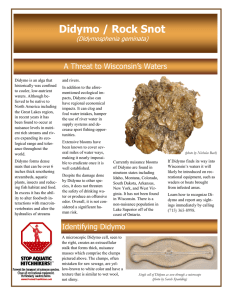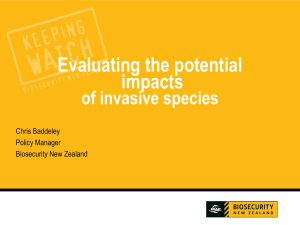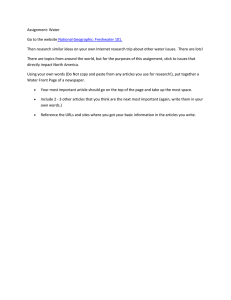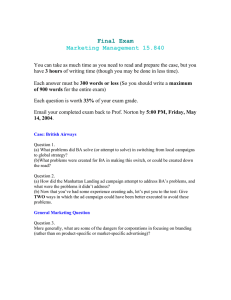Check, Clean, Dry - The National Social Marketing Centre
advertisement
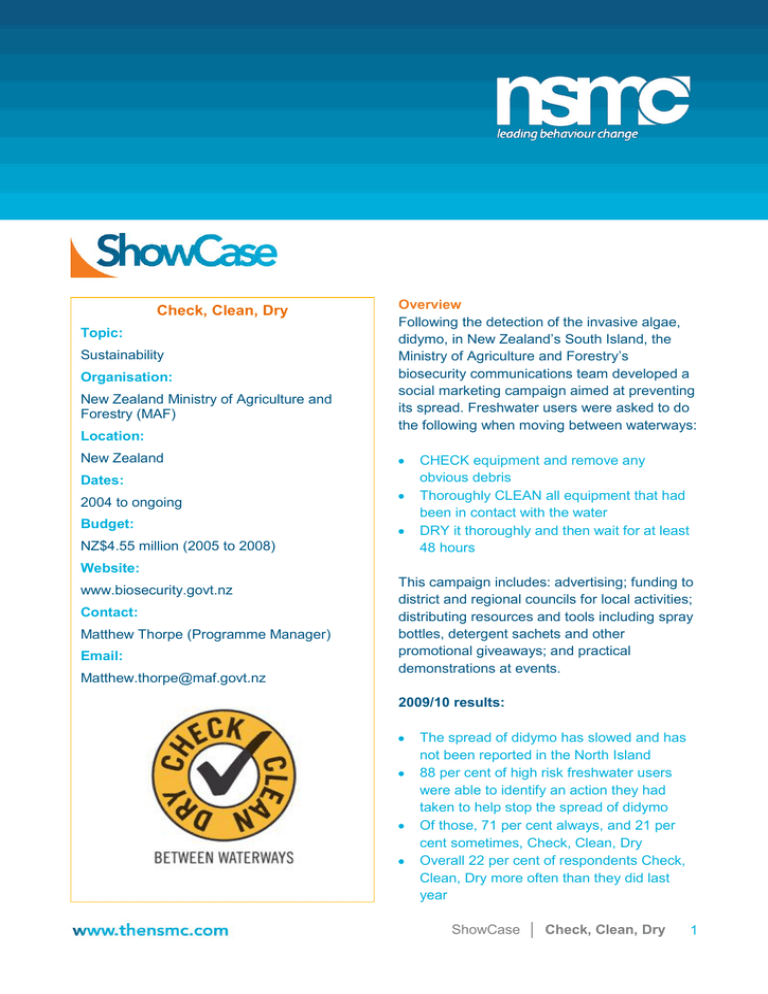
Check, Clean, Dry Topic: Sustainability Organisation: New Zealand Ministry of Agriculture and Forestry (MAF) Location: New Zealand Dates: 2004 to ongoing Budget: NZ$4.55 million (2005 to 2008) Overview Following the detection of the invasive algae, didymo, in New Zealand’s South Island, the Ministry of Agriculture and Forestry’s biosecurity communications team developed a social marketing campaign aimed at preventing its spread. Freshwater users were asked to do the following when moving between waterways: CHECK equipment and remove any obvious debris Thoroughly CLEAN all equipment that had been in contact with the water DRY it thoroughly and then wait for at least 48 hours Website: www.biosecurity.govt.nz Contact: Matthew Thorpe (Programme Manager) Email: Matthew.thorpe@maf.govt.nz This campaign includes: advertising; funding to district and regional councils for local activities; distributing resources and tools including spray bottles, detergent sachets and other promotional giveaways; and practical demonstrations at events. 2009/10 results: The spread of didymo has slowed and has not been reported in the North Island 88 per cent of high risk freshwater users were able to identify an action they had taken to help stop the spread of didymo Of those, 71 per cent always, and 21 per cent sometimes, Check, Clean, Dry Overall 22 per cent of respondents Check, Clean, Dry more often than they did last year ShowCase │ Check, Clean, Dry 1 New Zealand’s Ministry of Agriculture and Forestry biosecurity group (MAFBNZ) was set up in 2004 and faced a major challenge when the invasive microscopic algae, didymosphenia geminata (also known as didymo, or colloquially as ‘rock snot’) was first detected in New Zealand in November that year. It was found in the lower Waiau-Mararoa catchment at the very south of New Zealand’s South Island. To coordinate this work, a Didymo Long-Term Management programme was set up, which would be overseen by a Steering Group of representatives from the different regions and different stakeholder organisations to provide cross-sector governance and coordination. The Steering Group would also work alongside partner organisations to ensure the outcome and objectives for didymo long-term management were achieved. MAFBNZ obtained ring-fenced funding in 2004 for the social marketing campaign, which would be available until 2011/12. New Zealand is known for its iconic glistening waterways that house wildlife, are areas of recreation for New Zealanders and tourists, and form a key part of New Zealand’s identity. While not a significant health risk for humans, didymo threatens all of this, as pristine waterways become murky as they are filled with thick brown layers of the algae, which covers plants and rocks. Didymo can form large blooms on the bottom of streams, rivers and lakes, destroying the habitats on which a number of organisms depend for survival. MAFBNZ needed to act decisively to stop the spread of didymo across New Zealand, particularly to the North Island. Due to the lack of knowledge about didymo itself, a didymo science programme was set up to research ways to identify and detect didymo, how it spreads and how it could be eradicated or controlled. The programme found that didymo cannot be eradicated and so work had to be done to minimise its spread. However, this was not going to be easy. The programme discovered that didymo can be spread through a single drop of water, which can contain up to 1,000 didymo cells. Subsequently, a social marketing campaign was needed to encourage those who came in contact with the waterways to adopt behaviours to minimise didymo cells being transported from one waterway to another. Following research conducted by the didymo science programme, New Zealand’s National Institute of Water and Atmospheric Research (NIWA) released a report in February 2005 outlining its research into methods for containing didymo through decontamination of equipment or clothing that came into contact with fresh water. The report showed decontamination was relatively easy and could be conducted by waterway users using everyday household products such as nappy cleaner, antiseptics and detergent. ShowCase │ Check, Clean, Dry 2 and move between waterways (rivers, lakes) either between the North and South Island or in the same Island’. The following four activities/audiences were identified as likely high-risk freshwater users and therefore primary audiences for the campaign: Fishermen (anglers, eelers, whitebaiters) Kayakers Jet boaters Weekend or pleasure boaters These include both New Zealanders and visitors to New Zealand. Secondary audiences, who would also need to be considered, were identified as: Behavioural goals The evidence produced by the didymo science programme pointed to one behavioural solution to hindering the spread of didymo: freshwater users need to decontaminate clothing and equipment between waterways. Specifically they needed to: CHECK equipment and remove any obvious debris; Thoroughly CLEAN all equipment that had been in contact with the water with the most practical treatment (such as detergent, bleach, hot water); and DRY it thoroughly, and then wait for at least 48 hours Segmentation The Nielson Company conducted six focus groups with freshwater users across the South and North Islands. Based on this research high-risk freshwater users were defined as those who have ‘taken part in waterway activities four times or more in the last year, Trampers (hikers) Multi-sporters (such as mountain runners, as opposed to triathletes) School children Swimmers Drivers (usually of four-wheel drives) Primary research Following the focus groups to identify high-risk freshwater users, surveys were conducted with the four primary target audiences in both the South Island and the North Island to understand the target audiences’ attitudes and behaviours, and barriers and motivators to adopting the desired behaviour. The research drew on three theories of behaviour change when assessing answers to the following questions in the surveys: How close are the audiences to making a particular behaviour change? (Transtheoretical Model, otherwise known as Stages of Change Theory) What factors are influencing the audience’s stage of behaviour change? (Social Cognitive Theory) ShowCase │ Check, Clean, Dry 3 How can these factors and the audiences be moved in the desired direction? (Exchange Theory) To Check, Clean, Dry was perceived as time consuming and onerous Other barriers identified were: The surveys identified significant differences between groups in terms of their awareness, understanding and attitudes towards the threat of didymo, and in terms of the barriers and motivators to changing their behaviour. This allowed the researchers to identify groups of users with similar attitudes and behaviours in regards to: The role and importance of the natural environment in their overall experience Their attitude towards personal role and contribution in looking after the health of waterways and the natural environment Where they live: North Island versus South Island As such, three segments emerged: 1. ‘Guardians’ – Those who saw themselves as safeguarding the environment and waterways, because they see them as precious 2. ‘Taking for granted’ – Those who take for granted the environment and do not want to know or understand hygiene issues, and see waterways as purely recreational facilities 3. ‘Move on’ – Those who do not care about the water quality and see it as inevitable that it will deteriorate Worries about the effect of using cleaning solutions on the environment Worries about the effect cleaning solution could have on equipment, such as fishing flies and bicycles The availability and expense of cleaning solution Motivators All segments were motivated by the personal consequences the spread of didymo could have on their lives, whether impacting on their: Sporting activities Leisure activities The regions where they live The research also identified that is was important to emphasise that the government and MAFBNZ recognise the seriousness of the didymo problem and are committed to tackling the problem, so freshwater users did not feel the burden was too great and the cause ultimately pointless. Barriers Despite the different mind sets of freshwater users, two common barriers were identified: Didymo is a microscopic algae (until it blooms), which makes it difficult for people to believe it is present, and because they cannot see it, it is hard for freshwater users to understand they must Check, Clean, Dry every time they move between waterways MAFBNZ wanted to design a social marketing programme that took a community-based approach to target high-risk water user groups. This would involve working through the people ShowCase │ Check, Clean, Dry 4 and organisations they connect with, the publications they read, the waterways they use, and events they attend, while the message could be reinforced to the general public through mainstream media and traveller publications, locations and events. spread of invasive and unpleasant freshwater aquatic pests such as didymo We are all guardians of our rivers and lakes – we need to make every effort to stop freshwater aquatic pests from spreading and encourage others to do the same You can help protect our waterways from aquatic pests if you Check, Clean, Dry any gear that comes into contact with the water, between every waterway you use Even if didymo is not known to be in your area you still need to Check, Clean, Dry between waterways Human activity provides the greatest risk of spreading didymo and other freshwater pests You could be prosecuted and fined for knowingly spreading didymo and other freshwater pests Importantly, these messages are not static and can be updated depending on new information and audience needs. These messages are supported with the following interventions: Messaging The following messages underpin all communications to stakeholders and the general public. They were tested with the target audiences (by activity type) and with partners and stakeholders, and refined accordingly: Most people are actively doing the right thing to slow the spread of didymo (and recently other freshwater pests as well) by Checking, Cleaning, Drying between fresh waterways – we need to keep it up so our precious lakes and rivers stay free of these pests Our enjoyment of our fresh waterways depends on us all helping to slow the Partnerships The campaign utilises partnerships with numerous local and regional councils, environmental agencies, and community and sporting groups in the North and South Island, including kayak clubs, fishing clubs and rowing clubs. A stakeholder engagement plan was put together to identify how these different stakeholders can contribute to the programme and what their information and resource needs are to: Ensure all stakeholders have easy access to timely and relevant information and are aware of programme objectives, implementation and outcomes Continue to actively seek, listen to and act on feedback from stakeholders, partners and water users ShowCase │ Check, Clean, Dry 5 Actively work to broaden the network of stakeholders Actively work to build and maintain political support and buy-in for Check, Clean, Dry Ensure lines of communication and accountability are clear and feedback channels efficient Emphasise the penalties for noncompliance (where relevant) Resources and tools The campaign sought to develop and distribute resources and tools that would overcome the barriers to checking, cleaning and drying equipment and clothing between waterways, which were identified in the scoping phase. The resources and tools developed promote the fact that good planning makes the need to Check, Clean, Dry less time consuming. For instance, if a freshwater user is only using one waterway every weekend, then the majority of equipment will have time to dry before moving to another waterway. (including beach houses and Department of Conservation huts), thus overcoming the barrier of perceived difficult access to and high cost of cleaning solutions. Resources, tools and promotional giveaways were developed, including: Information packs (including leaflets, stickers and pens) Detergent sachets (using biodegradable detergent to overcome fears that detergents to clean equipment would be harmful to the environment) Spray bottles Cleaning station signage Bumper stickers Key rings Water bottles Branded jelly beans Branded sunscreen Practical demonstrations The team identified local events, such as rowing meets, jet boat marathons and boat shows, to provide practical demonstrations on how to Check, Clean, Dry specific equipment and clothing. Alongside promotional giveaways, materials were developed for such events, including a Check, Clean, Dry branded tent, flags and pull-up banners. To overcome the fears that cleaning solutions would damage equipment, the campaign recommends several different cleaning solutions so that people can choose one that suits their activity and equipment. For instance, rafters do not use dishwashing detergent as it becomes very slippery and can instead use a salt water solution. In general detergents are recommended because it can be bought cheaply and is available at many places ShowCase │ Check, Clean, Dry 6 Funding for local activities Funding is provided to help regional council’s organisations coordinate their own Check, Clean, Dry promotional activities, to contribute towards a nationally coordinated approach. clothing. Utilising organisations that are trusted information sources also ensures this message is sustainable, as it becomes embedded into their communications with their members. Advertising Advertising through targeted media is used to reach appropriate audiences. These include signage by waterways, advertising on ferries and at ferry terminals, radio communications and newspaper advertising. Targeted messaging for tourists A range of information is provided to tourists visiting New Zealand, including at airports (such as signage on baggage carousels), information on the Ministry of Agriculture and Forestry website, information distributed via the tourism industry and organisations, and changes to the arrivals declaration card to include declaration of freshwater equipment, information and collateral for arriving passengers with freshwater equipment. Before the didymo science programme was set up, the expectation for the campaign was to influence behaviour to stop the spread of didymo. However, by the time the social marketing campaign was launched in 2005/06, this focus was on slowing the spread of didymo, as research made it clear that stopping the spread of didymo completely would not be possible. A key aspect of the campaign has been working with organisations trusted by freshwater users. By disseminating the Check, Clean, Dry message through such organisations it has become almost taboo not to Check, Clean, Dry one’s equipment and The role of partners was further strengthened in late 2008 with the establishment of the Check, Clean, Dry Advisory Group (CCDAG), which involves partner organisations from both North Island and South Island, including the Department of Conservation, Fish and Game New Zealand, the Maori Trust and related industries. The CCDAG has input into the direction of the campaign and its implementation, focused on developing and distributing tools and collateral that will meet the needs of partner organisations and assist them in extending the programme through their own promotional and enforcement activities. Events involving discussions and demonstrations on how to Clean, Check, Dry have been very successful in reaching people. This work has been particularly successful, as ShowCase │ Check, Clean, Dry 7 it is supported by research with specific audiences and activities. The messages and communications at such events can be tailored according to which activity group will be attending, to ensure the information is relevant and will resonate with the audience. to ensure this important stakeholder is satisfied with all materials produced. An important part of the campaign to ensure its continued success has been the ongoing research and evaluation programme, which feeds back into further developments of the campaign. This allows for continual improvement and makes sure that the campaign keeps in touch with the attitudes of the target audiences. For instance, initially there was a big focus on freshwater fishers as a high-risk audience. However, as the campaign has progressed, this group has become more of an advocate for the message and is highly compliant. This means that messages to freshwater fishers no longer need to focus on getting them to Check, Clean, Dry – instead, this audience is encouraged to promote this message to others. One initiative that had to be scaled back was the use of cleaning stations. Initially a number of cleaning stations were set up in key locations near rivers, lakes and other waterways. However, these proved hard to maintain, so the number of cleaning stations was reduced to a few of the most used waterways. The Check, Clean, Dry campaign is evaluated by an annual survey that measures attitudes and reported behaviour change, alongside tracking studies of how far and wide didymo has spread within New Zealand waterways. One problem that arose was that the development of a poster that resonated with the audience was later objected to by the tourism industry. The poster showed a bungee jumper covered in didymo, to show how the spread of didymo could impact on this popular recreational activity. However, because bungee jumping is particularly popular with tourists, the Tourism Association felt this impacted negatively on New Zealand’s reputation as a tourist destination. As a result, all further testing of materials has involved the tourism industry 2009/10 results The most recent research conducted by research agency Synovate in June 2010 concluded that the Check, Clean, Dry campaign has been successful in changing attitudes and behaviours of New Zealand’s fresh waterway users. To date, the spread of didymo has slowed and there is yet to be a reporting of didymo in the North Island. People are Checking, Cleaning and Drying more often. 88 per cent of high-risk freshwater ShowCase │ Check, Clean, Dry 8 users (averaged across activities) were able to identify an action they take to help stop the spread of didymo. Of those, 71 per cent always Check, Clean, Dry, and 21 per cent sometimes Check, Clean, Dry. Other behaviours people have adopted include using different equipment (such as waders and fishing rods) between different waterways. There is a correlation between the social marketing campaign’s outputs and the desired behaviour: 98 per cent of people who always Check, Clean, Dry, and 95 per cent of people who sometimes Check, Clean, Dry, have seen promotional items or received information from the campaign. The measurement relies on self-reported behaviour change. But even so, there has been a significant improvement in people at least reporting that they do Check, Clean, Dry, with 22 per cent of respondents reporting they are more vigilant than they were a year ago. The proportions of high-risk freshwater users who state they think about how they can personally stop the spread of didymo, who state they have taken actions to do so, and who state they always make an effort to Check, Clean, Dry have all shown improvement yearon-year between 2006 and 2009. Value for money An Economic Impact Assessment (EIA) of the Check, Clean, Dry campaign in March 2006 projected that as a result of the North Island staying free of didymo, the cost-saving to New Zealand was an estimated NZ$11 million up to June 2008. The cost of the Check, Clean, Dry campaign interventions from 2005 to 2008 was NZ$5 million. Therefore the cost-saving to New Zealand by delaying the spread of didymo to the North Island is estimated to be NZ$2.15 for every NZ$1 spent on the campaign. If the North Island remains free of didymo to June 2012, the ratio is estimated to be NZ$7.61 for every NZ$1 spent. Partnerships and sharing learning are vital for the success of the campaign. For this reason the campaign works to ensure that all partner organisations are kept up-to-date, can provide feedback on how the campaign is doing, and continue to have input into the direction of the campaign through the following channels and networks: The Check, Clean, Dry Advisory Group The Biosecurity Managers Group The Didymo Long-Term Management Steering Group The Regional Council Communications Group The didymo.net online portal Relevant publications, such as Biosecurity magazine and the Biosecurity Institute’s Protect newsletter Monthly telephone conferences Regional meetings While the campaign has previously focused on kayakers, fishermen, anglers and jet-boaters as the four high-risk freshwater users, research from 2009/10 supports an expansion of the campaign to include other audiences such as trampers (hikers) and four-wheel drivers. Further research will help to support tailored communications for these additional target audiences. While the Check, Clean, Dry campaign was initiated to combat the spread of didymo, it is now working to stand alongside and enhance other freshwater pest programmes already in place. The focus of the Check, Clean, Dry campaign is to get users of freshwater systems to Check, Clean, Dry when moving between waterways and this hygiene behaviour applies ShowCase │ Check, Clean, Dry 9 to other freshwater pests as well as didymo. Reducing the spread of other freshwater pests supports the campaign’s message that the Check, Clean, Dry behaviour should be carried out every time freshwater users go between waterways. Partnerships Working in a partnership has been essential for the campaign. However this has meant that making decisions takes longer. All partners, both within government and industry, have different drivers and organisational focuses. There is, however, common ground in that all want to achieve the same thing, which is to stop the spread of didymo (and more recently all freshwater pests). After early ‘negotiations’, everyone has worked well together, sharing resources, funding, staff, ideas, equipment, suppliers and branding. Placating concerns There were concerns that the Check, Clean, Dry campaign was not working, as didymo was spreading around the South Island. This was due to didymo being able to be spread by a single drop of water rather than any failings in the campaign. Explaining that the campaign is trying to change behaviours (by getting people to Check, Clean Dry every time they move between waterways) and by focusing on freshwater hygiene and all freshwater pests (not just didymo) has helped reduce concerns. Lessons learned Tackling confusion The fact that didymo is a microscopic organism has caused some confusion. Many people believed that they could tell if a waterway was infected or not by looking and so were selfassessing the waterways. Others wanted the campaign to list all waterways that had didymo, but because testing is difficult, expensive and infrequent this is not possible. Subsequently, the campaign continues to emphasise that people should treat all waterways as though they have freshwater pests. Lack of enforcement One major obstacle has been the lack of any practical enforcement measures available to work alongside the social marketing campaign. There is still a small noncompliant audience that may respond to enforcement measures, but enforcement is very difficult for an issue like this. Combating complacency The original assessment of didymo and the damage it could cause was based on the worst case scenario, and some of the issues did not arise. This led to some complacency: ‘didymo is not as bad as we first thought it would be’. The campaign has attempted to tackle this with the information that there were also things that Partner organisations are being further encouraged, and where possible supported, to extend the Check, Clean, Dry message in ways that make it relevant to their own regions and audiences through, for example, tailored regional collateral. ShowCase │ Check, Clean, Dry 10 did occur that had not been envisaged, such as damage to irrigation pumps, movement controls of fish stocks and gravel, and problems with power generators. In addition, the fact that didymo has not been detected in the North Island has created some apathy in that part of the country. The campaign is dealing with this by focusing on other North Island freshwater pests. ShowCase │ Check, Clean, Dry 11
